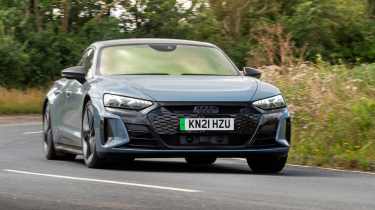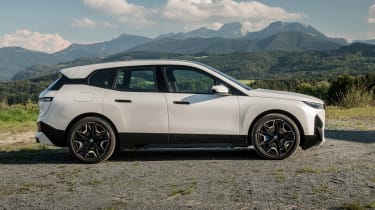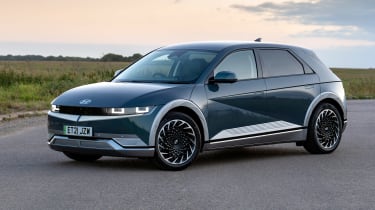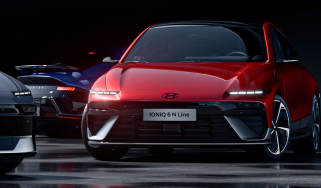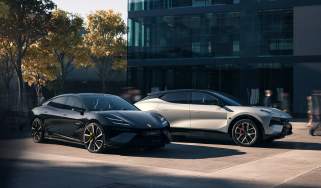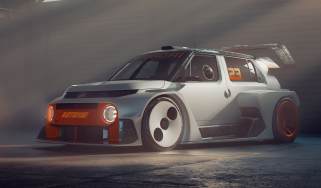How to design a car (part six): electric vehicle design
The necessary size of electric vehicles is bringing new challenges for car designers, and some are doing better than others, reckons Stevens
One of the things that continues to surprise me about electric vehicles is how big they are. I looked in on a Renault dealer recently to try a Renault Zoe and in the showroom what I was confronted with was a rather big car that Renault describes as a small car. But the Zoe was dwarfed by the new Arkana hybrid, a kind of four-door fastback coupe SUV.
I’m used to cars shrinking when they’re taken outside – that’s why I always insist on viewing a design project in an outdoor evaluation space, and why I would never make design decisions just on a computer screen – but out of doors both Renaults were still big. This is really not surprising because, like ICE cars, an EV is all about storing energy and then using it to move the thing down the road.
> How to design a car (part five): the dashboard
I am not in the least opposed to electric cars, but to store the same amount of energy as 10 litres of diesel, an electric car, using some kind of lithium battery, needs more than 200 litres of storage capacity. There are claims of more than 250 miles on a single charge with a 75kWh battery driving a 150kW (201bhp) motor with an overall vehicle weight of around two tons. Clearly if you want more range you need a bigger battery, and that means more weight, so twice the number of battery cells does not give twice the range.
The size of EV batteries is the most obvious reason why we are all being sold on the idea that big SUVs are the future, and the scramble to find ‘a new design language’ for EVs is really a search for new ways to disguise the growing bulk of the industry’s products.
Taking visual weight out of the side view of the car is the common starting point. This can be done just with a colour break: black sills are easy and cheap to do, and you’ll see them on the likes of the Hyundai Kona and Nissan Ariya. A sill that protrudes beyond the bottom of the doors can take out visual weight too, but it is very unlikely that a door will fit the body on all four edges – it’s one of the major panel-fit challenges for any manufacturer. (The same goes for a bonnet, bootlid or rear hatch.) That is why there are all sorts of clever industry solutions to hide the less well-fitting edges. The Mercedes EQE attempts to get away with a clean body side with just a bright trim at the bottom of the doors, but the side panels look very deep and make the car look as heavy as it no doubt is.
Audi uses a number of different stylistic solutions to hide the visual weight of its current and upcoming electric vehicles. Its designers chose a single outward ‘sill blister’ form for the 2021 Q5, two sill blisters for the e-tron GT and three for the Q4 Sportback e-tron. Clearly size matters to Audi, and the more styling features on the side panels, the more it believes it has bulk under control.
For quite a few years Renault has used a clever styling trick to reduce the apparent bulk of many of its models; it could be seen as a feature of the brand’s design language. The Scenic, Kadjar, Captur, Arkana and Clio all use an arched line on the lower section of the door/doors, the effect being to dramatically reduce the visual weight of the cars when viewed from the side. It must be carefully controlled, though, as this line can give the appearance of a very underfed dog should it have too much ‘arch’ to it. Other companies have copied this line, such as Dacia, Nissan, Hyundai, Toyota, and Jaguar with its I‑Pace. (Is it not time for a bit of originality here, chaps?) The Genesis GV60 develops this line in a very sophisticated manner to enhance what is possibly one of the best-looking future EVs.
A bit like Porsche with its EVs, Tesla just seems to accept that its cars look heavy and unexciting. Who has ever bought a Tesla because they love the lithe looks? It is always a surprise to me how enormous a Tesla X looks when it looms alongside my Subaru, but then a two-and-a-half-ton SUV is never going to be small! The original aim of Tesla was to produce an inoffensive, conventional-looking car that happened to be powered by electricity. Chief designer Franz von Holzhausen, who had previously worked for VW, GM and Mazda, must have been taken aback by the size of the package he was confronted with and then had to clothe in an uncontroversial manner. I doubt that the production Tesla Cybertruck, if it ever appears, will give a message of lightweight excitement.
Hyundai’s Ioniq 5 is beginning to be seen on UK roads and is a not unpleasing form. The upper surfaces of the front and rear are the sort of tidy design we have come to expect from design director Peter Schreyer, but the flat angled lower panels picked out in silver appear to have come from a different hand, and I can find no explanation for the diagonal crease line across the doors that looks like mysterious accident damage.
BMW’s chief designer Domagoj Dukec says that he is aware of the considerable critical noise regarding the brand’s EVs. ‘I’m reading social media and press, and I can see that some people are wondering where BMW is heading, but I can assure you that we have a clear vision about where we’re going. We all love the brand,’ he says, adding: ‘It is not our goal to please everyone in the world. You can’t make a design which pleases everyone. But you have to please your customers.’
BMW believes that 70 per cent of its customers are ‘business persons of success, who want the best but don’t want to shout about it’. The remaining 30 per cent are considered to be a group of buyers who are ‘very self-confident’. Does this suggest that BMW’s design direction for its electric vehicles is aimed towards that 30 per cent who do not have a memory of those glorious engines from the past?
The i4 saloon and iX SUV are a strange mix of design elements. The doors are as dull and uninspiring as those of any early 2000s car, whilst the front and rear ends are not just challenging but clearly unloved by BMW enthusiasts. It’s where these extreme surfaces meet the side panels that everything goes wrong. The wheelarches are presented as being separate sharp-edged panels that sit uncomfortably on the side surface. When you have a comparatively limited amount of stored energy that cannot be replenished in two minutes, efficiency becomes ever more important. And yet the front corners of these cars are the antithesis of aerodynamic efficiency, where the designer’s task must be to guide the airflow as smoothly as possible around that corner. An enormous, sharp-edged, fake brake-cooling duct cannot do that. Hopefully the recent BMW XM Concept will not be the culmination of this design direction.
For those who may think that BMW is alone in having lost control of its styling department and any understanding of its design heritage there are more shocks to their sensibility to come from Toyota and its reluctant sibling Subaru. The Toyota bZ4X electric SUV manages to pile onto its side view more than fifteen conflicting lines, and unfortunately the senior partner has bequeathed to the Subaru Solterra a similar excess of stylistic chaos for their shared platform. BMW’s ‘very self-confident’ target customers will need to be shared among quite a few manufacturers by the look of it.
